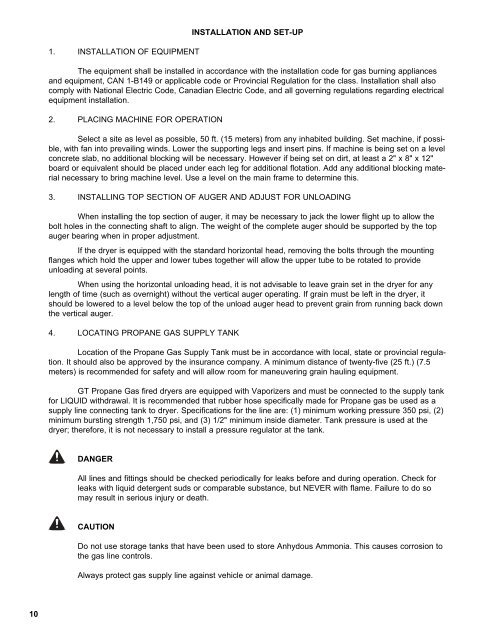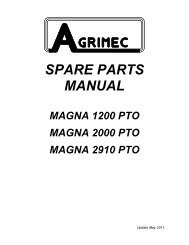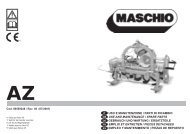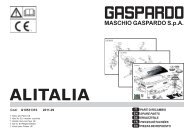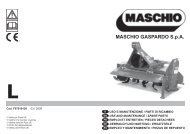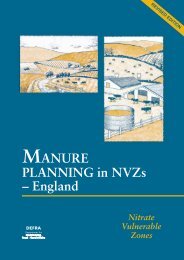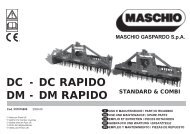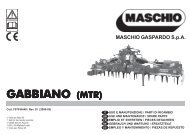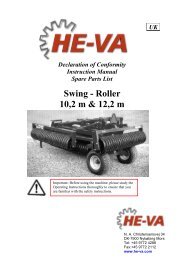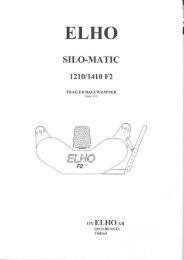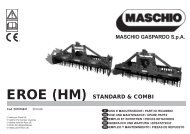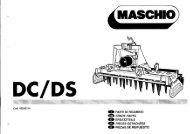GRAIN DRYER & PARTS BOOK - Opico
GRAIN DRYER & PARTS BOOK - Opico
GRAIN DRYER & PARTS BOOK - Opico
Create successful ePaper yourself
Turn your PDF publications into a flip-book with our unique Google optimized e-Paper software.
1. INSTALLATION OF EQUIPMENT<br />
INSTALLATION AND SET-UP<br />
The equipment shall be installed in accordance with the installation code for gas burning appliances<br />
and equipment, CAN 1-B149 or applicable code or Provincial Regulation for the class. Installation shall also<br />
comply with National Electric Code, Canadian Electric Code, and all governing regulations regarding electrical<br />
equipment installation.<br />
2. PLACING MACHINE FOR OPERATION<br />
Select a site as level as possible, 50 ft. (15 meters) from any inhabited building. Set machine, if possible,<br />
with fan into prevailing winds. Lower the supporting legs and insert pins. If machine is being set on a level<br />
concrete slab, no additional blocking will be necessary. However if being set on dirt, at least a 2" x 8" x 12"<br />
board or equivalent should be placed under each leg for additional flotation. Add any additional blocking material<br />
necessary to bring machine level. Use a level on the main frame to determine this.<br />
3. INSTALLING TOP SECTION OF AUGER AND ADJUST FOR UNLOADING<br />
When installing the top section of auger, it may be necessary to jack the lower flight up to allow the<br />
bolt holes in the connecting shaft to align. The weight of the complete auger should be supported by the top<br />
auger bearing when in proper adjustment.<br />
If the dryer is equipped with the standard horizontal head, removing the bolts through the mounting<br />
flanges which hold the upper and lower tubes together will allow the upper tube to be rotated to provide<br />
unloading at several points.<br />
When using the horizontal unloading head, it is not advisable to leave grain set in the dryer for any<br />
length of time (such as overnight) without the vertical auger operating. If grain must be left in the dryer, it<br />
should be lowered to a level below the top of the unload auger head to prevent grain from running back down<br />
the vertical auger.<br />
4. LOCATING PROPANE GAS SUPPLY TANK<br />
Location of the Propane Gas Supply Tank must be in accordance with local, state or provincial regulation.<br />
It should also be approved by the insurance company. A minimum distance of twenty-five (25 ft.) (7.5<br />
meters) is recommended for safety and will allow room for maneuvering grain hauling equipment.<br />
GT Propane Gas fired dryers are equipped with Vaporizers and must be connected to the supply tank<br />
for LIQUID withdrawal. It is recommended that rubber hose specifically made for Propane gas be used as a<br />
supply line connecting tank to dryer. Specifications for the line are: (1) minimum working pressure 350 psi, (2)<br />
minimum bursting strength 1,750 psi, and (3) 1/2" minimum inside diameter. Tank pressure is used at the<br />
dryer; therefore, it is not necessary to install a pressure regulator at the tank.<br />
DANGER<br />
All lines and fittings should be checked periodically for leaks before and during operation. Check for<br />
leaks with liquid detergent suds or comparable substance, but NEVER with flame. Failure to do so<br />
may result in serious injury or death.<br />
CAUTION<br />
Do not use storage tanks that have been used to store Anhydous Ammonia. This causes corrosion to<br />
the gas line controls.<br />
Always protect gas supply line against vehicle or animal damage.<br />
10


